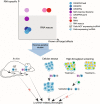Reverse-genetics studies of lncRNAs-what we have learnt and paths forward
- PMID: 32290841
- PMCID: PMC7155256
- DOI: 10.1186/s13059-020-01994-5
Reverse-genetics studies of lncRNAs-what we have learnt and paths forward
Abstract
Long non-coding RNAs (lncRNAs) represent a major fraction of the transcriptome in multicellular organisms. Although a handful of well-studied lncRNAs are broadly recognized as biologically meaningful, the fraction of such transcripts out of the entire collection of lncRNAs remains a subject of vigorous debate. Here we review the evidence for and against biological functionalities of lncRNAs and attempt to arrive at potential modes of lncRNA functionality that would reconcile the contradictory conclusions. Finally, we discuss different strategies of phenotypic analyses that could be used to investigate such modes of lncRNA functionality.
Conflict of interest statement
The authors declare that they have no competing interests.
Figures


Similar articles
-
Evolutionary annotation of conserved long non-coding RNAs in major mammalian species.Sci China Life Sci. 2015 Aug;58(8):787-98. doi: 10.1007/s11427-015-4881-9. Epub 2015 Jun 27. Sci China Life Sci. 2015. PMID: 26117828
-
Long noncoding RNA repertoire in chicken liver and adipose tissue.Genet Sel Evol. 2017 Jan 10;49(1):6. doi: 10.1186/s12711-016-0275-0. Genet Sel Evol. 2017. PMID: 28073357 Free PMC article.
-
Transposable elements are major contributors to the origin, diversification, and regulation of vertebrate long noncoding RNAs.PLoS Genet. 2013 Apr;9(4):e1003470. doi: 10.1371/journal.pgen.1003470. Epub 2013 Apr 25. PLoS Genet. 2013. PMID: 23637635 Free PMC article.
-
Roles of long noncoding RNAs in brain development, functional diversification and neurodegenerative diseases.Brain Res Bull. 2013 Aug;97:69-80. doi: 10.1016/j.brainresbull.2013.06.001. Epub 2013 Jun 10. Brain Res Bull. 2013. PMID: 23756188 Review.
-
Long non-coding RNAs as new regulators of cardiac electrophysiology and arrhythmias: Molecular mechanisms, therapeutic implications and challenges.Pharmacol Ther. 2019 Nov;203:107389. doi: 10.1016/j.pharmthera.2019.06.011. Epub 2019 Jul 2. Pharmacol Ther. 2019. PMID: 31271794 Review.
Cited by
-
Long non-coding RNA screening and identification of potential biomarkers for type 2 diabetes.J Clin Lab Anal. 2022 Apr;36(4):e24280. doi: 10.1002/jcla.24280. Epub 2022 Mar 7. J Clin Lab Anal. 2022. PMID: 35257412 Free PMC article.
-
Lessons from discovery of true ADAR RNA editing sites in a human cell line.BMC Biol. 2023 Jul 19;21(1):160. doi: 10.1186/s12915-023-01651-w. BMC Biol. 2023. PMID: 37468903 Free PMC article.
-
The choice of negative control antisense oligonucleotides dramatically impacts downstream analysis depending on the cellular background.BMC Genom Data. 2021 Sep 14;22(1):33. doi: 10.1186/s12863-021-00992-1. BMC Genom Data. 2021. PMID: 34521352 Free PMC article.
-
Localization is the key to action: regulatory peculiarities of lncRNAs.Front Genet. 2024 Dec 16;15:1478352. doi: 10.3389/fgene.2024.1478352. eCollection 2024. Front Genet. 2024. PMID: 39737005 Free PMC article. Review.
-
Building genomes to understand biology.Nat Commun. 2020 Dec 2;11(1):6177. doi: 10.1038/s41467-020-19753-2. Nat Commun. 2020. PMID: 33268788 Free PMC article. Review.
References
Publication types
MeSH terms
Substances
LinkOut - more resources
Full Text Sources

